with Andrew Haught
Andrew takes you through the beach landing process he employed so successfully in his battle against Wayne…
Join the Battlefront team as we launch Bagration: Soviet
with Andrew Haught
Andrew takes you through the beach landing process he employed so successfully in his battle against Wayne…
with Blair Mackey
While building this list I had two words in my head: ‘mobility’ and ‘utility’. I wanted to create a fast moving force that has a tool for every situation. For this I chose the US Cavalry Recon Company Command Card owing to its relatively inexpensive base requirements, and the tools it has.

The M8 Scotts will serve to lay out smoke ahead of assaults, pin enemy anti-tank assets, and dig out enemy infantry. Having a Veteran M4 Sherman 76mm Platoon gives me an option for dealing with heavy enemy tanks, with mobility on my side, and being cautious I can limit the potential return fire that I will face, while applying force to a specific part of the enemy line.
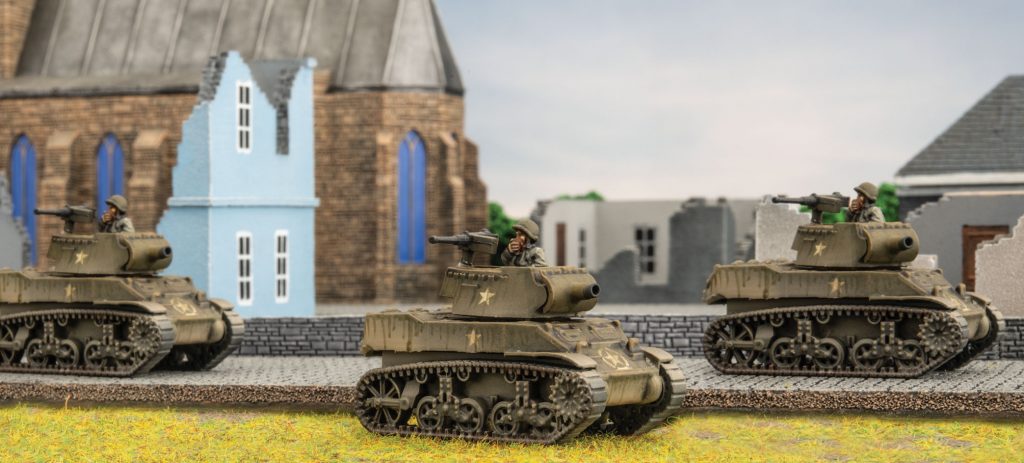
The Rangers exist for the purpose of chasing down enemy tank destroyers and captured bailed out enemy tanks. The L4 Grasshopper allows me to engage in counter battery fire against enemy artillery, and have eyes
on anti-tank assets without exposing my Scotts.
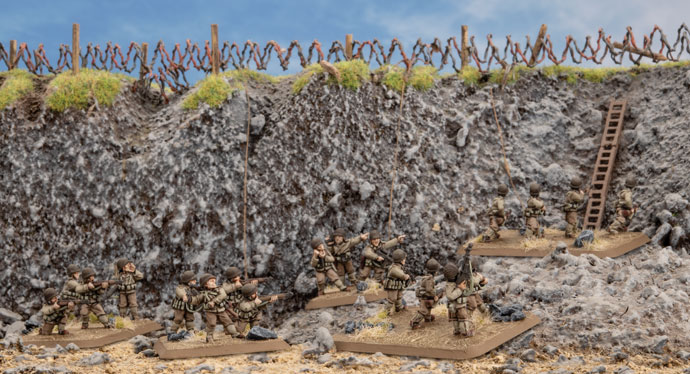
with Wayne and Andrew
Wayne and Andrew fight on the beaches of Normandy.
with Andrew Haught
The 29th Boat Assault Company have been near and dear to my heart since they first arrived years ago in the Bloody Omaha book, at that time I leaned heavily into numbers over elite units so it was an easy choice for me between the 29th and the Big Red One.
The US Assault Company is a unique Infantry company that has a mix of specialty weapons from Bazookas to Flame-Throwers, this unit has a weapon for every occasion. Along with this unique composition you have access to lots and lots of units in one formation. Having access to six core infantry units is a key aspect of this list.
Before getting into the list let’s look at what you get in a unit. For nine points you get:
5x M1 Grand Rifle Teams
2x M1 Bazooka Teams
1x 60mm Mortoar
1x Flame Thrower
As a bonus you can replace one of your Bazookas with M1919 LMG at no cost.
The version of the Assault Company I am running are Confident, Trained, and Aggressive. They also come with the Blood n’ Guts trait that gives them a 3+ to rally, that will keep my units moving forward. I could go with the Big Red One elite option, but the 29th is who I want to play. Since I am going for the cheaper version that is easier to hit, it is important then to make sure I have the numbers to absorb losses more easily.
To this end I am going to take 5 units of the Assault Boat Sections, adding in the HQ and M1917 Machine Gun platoon that gives me an even 50 points. I am choosing to leave the 2 Bazookas in each unit instead swapping any for the LMGs. I don’t think those units need the rate of fire since I am going to run two units of the Support Boat sections with the M1917 Machine Gun platoon for 5 points a unit, and I have a unit of M1917 guns. Adding in those units brings me up to an even 60 points.
Next I want to add some artillery; this will be simple as I already have loads of small one gun templates, so adding a full strength mortar platoon for 6 points would be ideal.
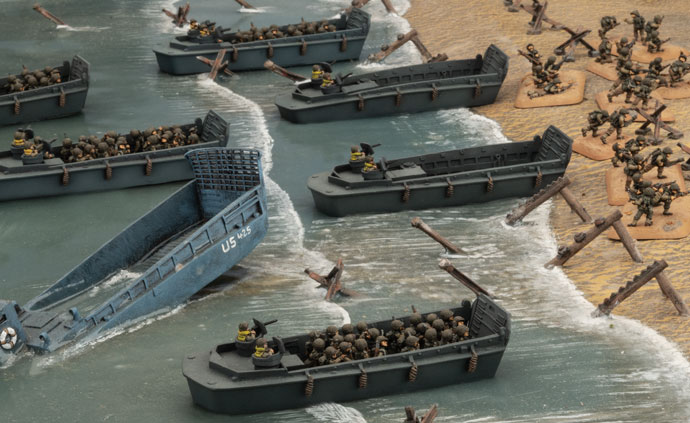
Now the list has some Achilles heels, I have no dedicated anti-air units so air-power can be quite effective against me. I am also weak against light tank lists, like a Stuart company. At a 100 points you can get 50 of them and at those numbers they will swamp me, my M10s don’t have enough shots to kill them all and the Stuarts AT is high enough to kill an M10 even when hitting front armour. But no list can cover all the bases and even against light tanks and air-power I will have a fighting chance, as I do still have loads of bazookas and my M10s have self-defence AA.
So here is my final list
Assault Company (66 points)
M10 Tank Destroyer Company (34 Points)
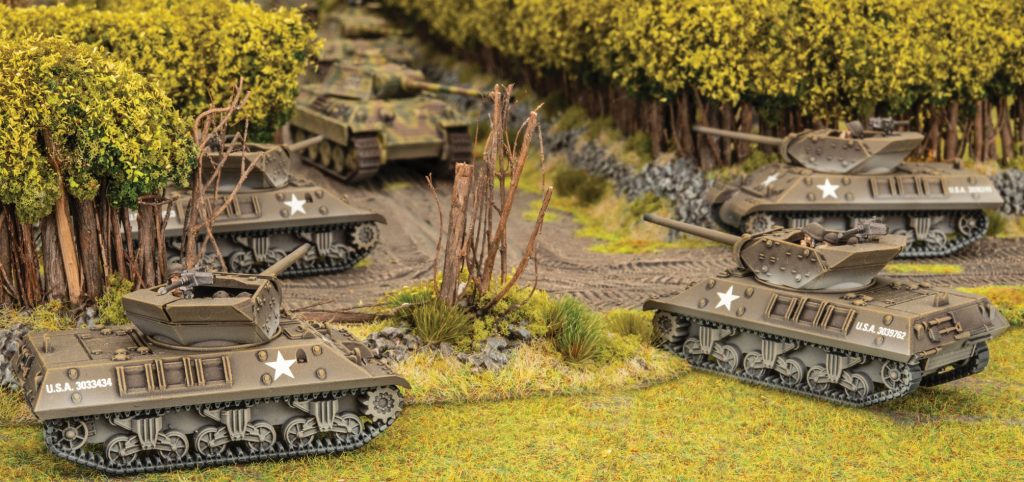
As a list this works really well- it’s easy to split it up when figuring out reserves and it is flexible with the ability to both attack and defend quite well. On the defence you place one Assault Boat Section and Support Boat Section on each objective, freeing the rest of your force to be placed in such a way that they can delay and assault the incoming enemy models. On the attack I would focus one objective, soften it up with the loads of artillery templates this list has and band all my infantry together and swarm the weakened objective. I will use my HMG and tanks to threaten any reinforcements to the attacked objective while also proving much needed fire support to my main attack.
Well, I hope this gives you an idea of how you want to build your beach landing company. Perhaps you want better quality of troops instead of numbers by swapping out the 29th with Big Red One, or maybe you do have a Stuart player in your area and you want Shermans instead of M10s. I highly suggest tweaking your lists to fit your local m eta and your playstyle.
Well that’s it until my next List Tech, hope to see you on the battlefield.
The Auckland Studio
Andrew is rebasing his Beach Assault Sections to add some fresh sand to the base and pop those flamethrowers on small bases.
Mike has come to join us for the launch and is touching up some proper big boy guns.
Patch, happy as ever, is setting up the lighting to record a throw down between Phil and Chris…
with Evan Allen
Nothing seems to cause as much confusion as colours of the uniforms worn by the United States Army during WWII. And this seems to be mainly due to the fact that the army entered the war in December 1941 wearing one uniform and finished the war in 1945 with another uniform, mixed them up in between, with a few other articles of clothing thrown in for good measure!
In this article I will attempt to portray these uniforms with pictures of BF miniatures painted with Vallejo’s Acrylics colours that I’ve personally chosen. So please treat all colour suggestions as a guide and not a decree. Also, I’ve purposely avoided one step in the painting process that I
normally use which is highlighting of the base colour. This is so you can see the original colour from the bottle and not just the highlighting I use,
which is add 10-15% VP Deck Tan (986) to the original base colour. For those that don’t use the
Vallejo range just cross-reference the
colours on the FOW colour chart to get your favourite paint brand equivalent. Throughout this article I’m going to use the designations that seem to be most commonly used to describe the uniforms and not necessarily the ‘official’ nomenclature.
7 December 1941. The United States is dragged forcibly into the war and the first US soldiers to see combat in the ETO, or ‘European Theatre of Operations’, land in Tunisia on 8 November 1942 during Operation Torch.
This figure is shown
wearing the M1941 or ‘Parsons’ jacket and Olive Drab woolen trousers with canvas leggings and M1 steel helmet. The G.I. in this uniform could be found in the Bocage hedgerows of Normandy to the snow-covered Ardennes, from the dusty Tunisian roads to the hills of Italy and anywhere else that a G.I. fought in the ETO.
| Uniform Part | Vallejo Colour |
| Jacket/leggings | Khaki (988) |
| Trousers | US Field Drab (873) |
| Webbing | Green Grey (886) |
| Helmet | Olive Drab (887) |
| Boots | Flat Brown (984) |
One uniform Item that can cause confusion is the HBT or ‘Herringbone Twill’ denim fatigue that the US Army issued. These were worn as working clothes during training etc. but were also worn over the top of the normal combat dress for amphibious operations such as the Tunisian
and Normandy landings. The olive green colour of the HBT’s was similar to the colour of the later M1943 uniform, which we’ll look at later.
These two figures (Above and left) show a mixture of HBT shirt and trousers mixed with the OD woolen trousers and M1941 jacket. Again, this would be a common mix anywhere the G.I. fought.
| Uniform Part | Vallejo Colour |
| Herringbone Twill | US Dark Green (893) |
(Note. To differentiate between HBT and the M1943 uniform I’d suggest adding more Deck Tan to the highlight colour for the HBT material)
To add to the figure with the Herringbone twill trouser choice is the additional items issued for the Normandy landings. These consisted of the Assault jacket, worn over the normal jacket, and the waterproof gasmask bag. The Assault jackets had extra pockets for things like grenades
and ammo magazines that wouldn’t hinder the troops onto the beaches . The Gasmask bags, well just because, who knew what the Germans would do under such pressure?
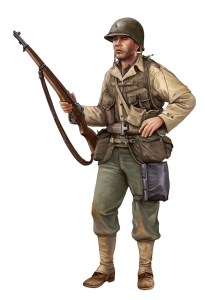
| Uniform Item | Vallejo Colour |
| Assault jacket | Vallejo Olive Drab (887) |
| Gasmask bag | German Grey (995) |

a result of the confusion. But this does make for an interesting looking G.I.
This camouflage uniform was basically the HBT uniform printed in a camouflage pattern.
| Uniform Part | Vallejo Colour |
| Uniform Base | Khaki (988) |
| Camo. | Flat Brown (984) |
| Camo. | US Dark Green (893) |
| Leggings | Khaki (988) |
| Webbing | Green Grey (886) |
A trick I’ve learnt with camouflage uniform painting is once you’ve finished the pattern then go over the whole figure with a light dry brush of the original base colour. This should help blend in the pattern and prevent it from being to ‘loud’.

The first issue was to the G.I.’s taking part in the Anzio landings in Italy and the new uniform proved itself an immediate success. Due to internal squabbling however, between the ETO command and the U.S. based command the issue of this much improved uniform was delayed until pretty much the end of the war for the troops already serving there. Most new troop formations that were shipped to the ETO after mid 1944 were wearing the new uniform but the rest had to soldier on through one of Europe’s worst winters wearing the older and less weather resistant uniform. With the new uniform also came ‘Shoe Pac’ which were an attempt to make the G.I.’s boots waterproof. They were a rubber and canvas overshoe that slipped over the boot and had metal clips to tighten. They were black in colour.
| Uniform Part | Vallejo Colour |
| M1943 uniform | US Dark Green (893) |
| Shoepacs | German Grey (995) |
| Webbing | Green Grey (886) |
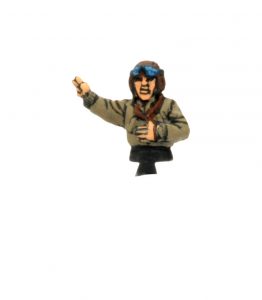
| Uniform Item | Vallejo Colour |
| Windcheater | Khaki (988) |
| Helmet | Flat Brown (984) |
The standard U.S helmet became popular with tank crews as the M1942 
| Uniform Part | Vallejo Colour |
| Helmet | Olive Drab (887) |
| Jacket | Khaki (988) |
Contrary to popular belief, if you’ve chosen an American force, you have a wide selection of paint schemes to choose from. Be it a ‘Gypsy’ mixture for a veteran unit or ‘uniform’ appearance for a freshly landed bunch of Greenhorns enjoy your painting and gaming.
with Chris Potter, BF UK
For me nothing typifies Late War like the Normandy invasion. The largest seaborne invasion in history? Check. The largest airborne drop of troops to date? Check. And all this against a dug in and entrenched foe, led by none other than the Desert Fox himself: Erwin Rommel.
When the Late War journey was announced and the information about the books started to come to fruition, I was in my element like a kid in a sweet shop. I was at the front of the queue when we had the Late War sale clutching my list of ‘must haves’ begging the boss to let me get my blisters and box sets. Like a lot of others, I had to wait my turn, much to the better half’s relief as my list far outweighed my wages.
But boy did the factory deliver. I managed to bag myself two boxes of US Parachute Infantry, to get my Band of Brothers Airborne fix, as well as a box of 29th Infantry for the all important beach landings. This would be the start of my D-Day Force. Because on the horizon I was being tempted by the new plastic Airborne sprues and some rather tasty kit in the form of new plastic jeeps and rumours of 80mm mortars to rain fire on the enemy.
However, Matt managed to bring me back to the present as he reminded me that we needed to put together forces for Fortress Europe before I got carried away with the US D-Day book. Sorry boys of the 29th and 101st, you will have to wait whilst the glory boys of the 3rd Armored have their time in the spotlight.
I don’t want to reiterate what has already been said by a thousand others, but nothing screams US dominance on the Western Front like the wonderful Sherman tank. Whatever version of Sherman, you see a group of these coming, and you know that the rest of the US forces are not far behind. They are the breakthrough, the reason that prior to D-Day in 1944 the plucky Brits designed a Duplex Drive (DD) system to allow them to ‘swim’ up the beach to smash the enemy. They even fitted them with canvas flotation devices to literally float them through the surf.
From Omaha to Caen, throughout Market Garden to the German homeland, Detroit’s finest were leading the way and looking good doing it!
So when I saw that the new US Combat Command contained no less than 5 Shermans, which when combined with the 8 found in the Hit The Beach starter set, meant I had the solid core needed for a Fortress Europe Armoured Company. Add into that, the Priests for some artillery support and the M10 Tank Destroyers for some long range AT, all I need is some Armoured Rifles to take and hold objectives.
I am really excited to field Americans in Late War for V4. At heart this is all about getting as many models onto the table all at once. My usual modus operandi is to get what looks cool, then play a few games and work out the weaknesses before changing up the army composition. This time will be no different. My first game is against Gareth’s Germans. Let’s see how the Combined Arms list compares and performs!
Pete the Wargamer shows you a great method of painting the M5 Stuart for Normandy…